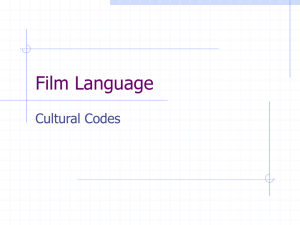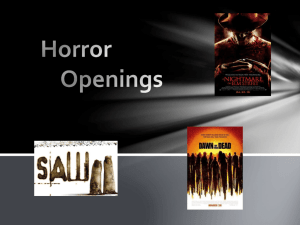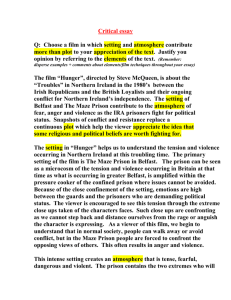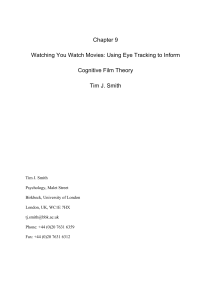Project AP-4 Analyze Picture Composition
advertisement
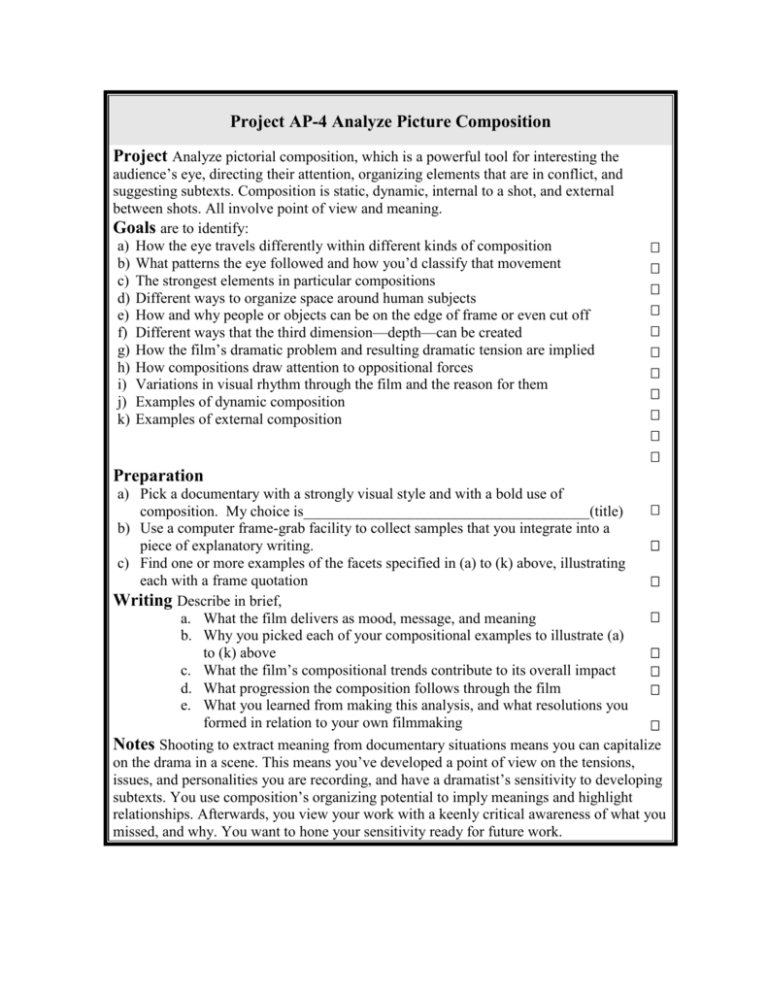
Project AP-4 Analyze Picture Composition Project Analyze pictorial composition, which is a powerful tool for interesting the audience’s eye, directing their attention, organizing elements that are in conflict, and suggesting subtexts. Composition is static, dynamic, internal to a shot, and external between shots. All involve point of view and meaning. Goals are to identify: a) How the eye travels differently within different kinds of composition b) What patterns the eye followed and how you’d classify that movement c) The strongest elements in particular compositions d) Different ways to organize space around human subjects e) How and why people or objects can be on the edge of frame or even cut off f) Different ways that the third dimension—depth—can be created g) How the film’s dramatic problem and resulting dramatic tension are implied h) How compositions draw attention to oppositional forces i) Variations in visual rhythm through the film and the reason for them j) Examples of dynamic composition k) Examples of external composition Preparation a) Pick a documentary with a strongly visual style and with a bold use of composition. My choice is______________________________________(title) b) Use a computer frame-grab facility to collect samples that you integrate into a piece of explanatory writing. c) Find one or more examples of the facets specified in (a) to (k) above, illustrating each with a frame quotation Writing Describe in brief, a. What the film delivers as mood, message, and meaning b. Why you picked each of your compositional examples to illustrate (a) to (k) above c. What the film’s compositional trends contribute to its overall impact d. What progression the composition follows through the film e. What you learned from making this analysis, and what resolutions you formed in relation to your own filmmaking Notes Shooting to extract meaning from documentary situations means you can capitalize on the drama in a scene. This means you’ve developed a point of view on the tensions, issues, and personalities you are recording, and have a dramatist’s sensitivity to developing subtexts. You use composition’s organizing potential to imply meanings and highlight relationships. Afterwards, you view your work with a keenly critical awareness of what you missed, and why. You want to hone your sensitivity ready for future work. When you operate a movie camera you are in the double role of audience and creator, with the viewer’s experience happening first. You react instinctively to each new image, your eye making a journey within it, registering the image’s subject and any meaning or narrative that emerges. Typical thoughts you have: What made my eye go to its particular starting point in the image? Was it the brightest point; the darkest; an arresting color; a human face or a significant junction of lines creating a focal point? Something else? What attracted my eye away from its point of first attraction, and what drew it onward to each new place? If I trace out the route my eye took, what shape do I have? A circular pattern; a triangle or ellipse; what else? How do I classify this compositional movement? Is it geometrical, repetitive textures, swirling, falling inwards, symmetrically divided down the middle, flowing diagonally…? Are places in my eye’s route specially charged with energy? Often these are sightlines, such as between two field workers, one of whom is facing away. How are the individuality and mood of the human subjects expressed? By making juxtapositions between person and person, person and surroundings? How much movement did my eye make before returning to its starting point? Aspects of visual design and some sample associations: Element Line Type Straight Possible association Man-made, purposeful, of the mind and intellect, designed, intentional, divisional. Line may be actual or implied. Curved or round Organic, flowing, soft, pliable, adaptable, undulating, enveloping Vertical Rising, falling, contesting, bisecting, dividing Horizontal Space, broadness, depth, calmness, limpidity, serenity, bisection above and Element Type Possible association below Diagonal Purpose, dynamism, movement, descending or ascending Converging Fulfillment, destination, completion, unification Diverging Separation, profusion, multiplication Between people or Tension; will; intention; potential for objects communication, antagonism, attraction, , questioning Eyeline Implied sightline that we are drawn to knowing Shape Organic Profusion, welcoming, fruitful, invasive, multiplying Texture Angular Orderly, defensive, purposeful, watchful Soft surfaces Springy, welcoming, resilient, disordered, comfortable, light absorbing, fluid Hard surfaces Definite, contained, defended, ordered, light reflecting, rigid Color Hue Colors have innumerable natural and cultural associations. The most obvious are red with blood and danger, green with safety and natural vegetation, white with purity, etc Saturation (degree of Saturation and desaturation have their purity or of dilution with associations and symbolic meanings white) connected with energy, assertiveness, boldness, etc. Brightness Lightness might suggest assertive, outgoing energy; darkness could mean withdrawal, subservience, or gloom. Juxtaposition What colors are juxtaposed to special effect? Element Type Dominant Possible association What color or colors predominates in the frame? Space Positive Usually the subject in arrangement with its (objects that constitute a surroundings picture’s subject) Negative Space that is sometimes a shape in its own (space around the right subject) Juxtaposition Balance Balanced or unbalanced frame suggesting harmony or disharmony? Depth Contrast Strong or weak? Intended or inherent? Repetition Patterns, mirroring? Background plane A sense of depth comes from lighting, Middleground plane perspective, or selective focus. Subject is Foreground plane normally focused in middleground, with foreground and background in lesser focus. Racking focus to a new plane shifts our attention to new detail. Framing Closed All narrative information is arranged and enclosed within the frame. Framing often suggests meaning or subtext. An aware camera operator sees in terms of relatedness and uses composition to further the ends of the film. Open A necessary narrative element is either obscured or is outside the frame; the frame may look partial or unarranged. Half a face may look out of frame, causing the viewer to imagine the rest. Balanced Elements are harmoniously arranged Element Type Unbalanced Possible association suggesting order and balance. May be intended to create unease, or may anticipate new element entering the frame, such as someone appearing out of a door. Frame within a frame A subframing, such as a room through whose window one sees outdoor activity framed by the window. Lead room Space ahead of someone facing across screen Unlike the viewer, you as the camera operator are responsible for what the audience sees, so you must immediately exploit values implicit or potential in the situation. Unlike a fiction operator, you often have no time to plan or think, and must rely on intuition and the values to which you have trained yourself to react.







